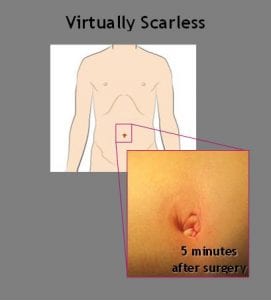Gallbladder Center

The Midwest Institute for Robotic Surgery at Silver Cross Hospital is a leader in performing robotic gallbladder (cholecystectomy) surgeries through a single incision in the belly button.
- Laura Ragauskaite, M.D., was the first female general surgeon in Illinois to offer Robotic Single-Site® Cholecystectomy.
- Surgeons at Silver Cross were the first in the Will and Grundy counties to perform Single-site® Cholecystectomy using the da Vinci® robot.
- Silver Cross is part of an elite group of nationally recognized General Surgery Epicenters.
- Physicians from all over the U.S. travel to Silver Cross Hospital to learn robotic and Single-Site® techniques from the surgical team.
Gallbladder Disease
The gallbladder is located below your liver in the right upper abdomen. The liver produces the bile, a fluid that helps digest fat. The gallbladder then stores the bile and releases it to the intestine when needed to help with digestion. Sometimes the gallbladder may need to be removed for various reasons, such as:
- Gallstones
- Gallbladder inflammation (cholecystitis)
- Stones in the duct (choledocholithiasis)
- Gallbladder dysfunction
Rest assured that you can actually live without the gallbladder because the bile can reach your intestine in other ways.
Gallstones
Gallstones are the most common gallbladder disease with 1 million new cases diagnosed each year. Over 25 million people have it in the U.S., and it is more common among women than men. In fact, gallstones are the leading cause of emergency department visits and hospital admissions for severe abdominal pain.
Risk Factors for Gallstones
- Female gender
- Family history of gallstones
- Over 40 years old
- Obesity or being overweight
- Rapid weight loss or “crash diets”
- Sedentary (inactive) lifestyle
- Liver disease
- Certain medications (e.g. birth control pills or cholesterol lowering drugs)
- Certain ethnicity (e.g. Native Americans, Mexican Americans)
Symptoms
Many people with gallstones do not have any symptoms and may not require treatment. Many other people do experience symptoms, especially pain. You may feel a severe steady pain in the upper abdomen or right side. The pain may also be between your shoulder blades or in the right shoulder. You may have a gallstone “attack” that occurs suddenly – it may last for 15 minutes, or as long as several hours. You may experience multiple attacks that are separated by weeks, months or years. These attacks often follow fatty meals and maybe at night.
See a doctor immediately if you experience any of these symptoms:
- Pain lasting for hours
- Nausea or vomiting
- Fever (even low-grade)
- Chills
- Yellowing of skin or eyes
- Clay-color stool
Gallstone Removal
If your gallstones are small and if you don’t have acute inflammation (cholecystitis), it might be possible to dissolve or break them up in order to naturally pass them out of your body, or to remove them using endoscopic retrograde cholangiopancreatography.
For most patients who experience symptoms from gallbladder disease, surgery to remove the gallbladder is often recommended. This is called “cholecystectomy” or “chole” in short. A general surgeon will perform this surgery in one of 4 ways:
- Open cholecystectomy
- Traditional laparoscopic cholecystectomy
- Robotic-assisted laparoscopic cholecystectomy (left image in illustration below)
- Robotic-assisted Single-Site® cholecystectomy (right image in illustration below)

Patients generally do well after surgery and have limited difficulty with digesting food. Remember, we can live without the gallbladder because the bile can reach the intestine through other ways.
Using a da Vinci® robot, the surgeon makes a few small incisions in the abdomen using long, thin instruments and a tiny camera. The camera sends images to a video monitor in the operating room to guide your surgeon during the operation. The robot is designed to provide surgeons with enhanced capabilities, including high definition 3D vision and a magnified view. Your doctor controls the robot, which translates his or her hand movements into smaller, precise movements of tiny instruments inside your body. The robot cannot act on its own. Surgery is performed entirely by the surgeon. At the end of the operation, the gallbladder is pulled out through the incision in the bellybutton.
Your surgeon may use Firefly™ Fluorescence Imaging to find vessels and tissue that couldn’t be seen by the human eye. Firefly combines a special video camera and a dye that binds to proteins to make those vessels and tissue visible during robotic surgery.
Single-Site® Cholecystectomy
At the Midwest Institute for Robotic Surgery at Silver Cross Hospital, surgeons are now using the da Vinci robot to perform the entire operation through a single incision in the belly button. After the incision heals, the scar is hidden inside the folds of the bellybutton and appears to be virtually scarless.
The potential benefits for patients include:
- Even less scarring and pain afterwards compared to traditional laparoscopic and robotic surgery
- Low rate of major complications
- Low conversion rate to open surgery
- Minimal blood loss
- Shorter hospital stay
- Fast recovery time
- High patient satisfaction

Some patients may not be able to have single-incision surgery for gallbladder removal. However, robotic-assisted surgery with a few small incisions in the abdomen may be an option. Your doctor should discuss all treatment and surgical options with you to help you decide which is best for your situation. As with any surgery, there are risks.
To be affiliated with the Midwest Institute of Robotic Surgery at Silver Cross Hospital, surgeons must meet rigorous criteria and demonstrate excellent outcomes and high patient satisfaction.